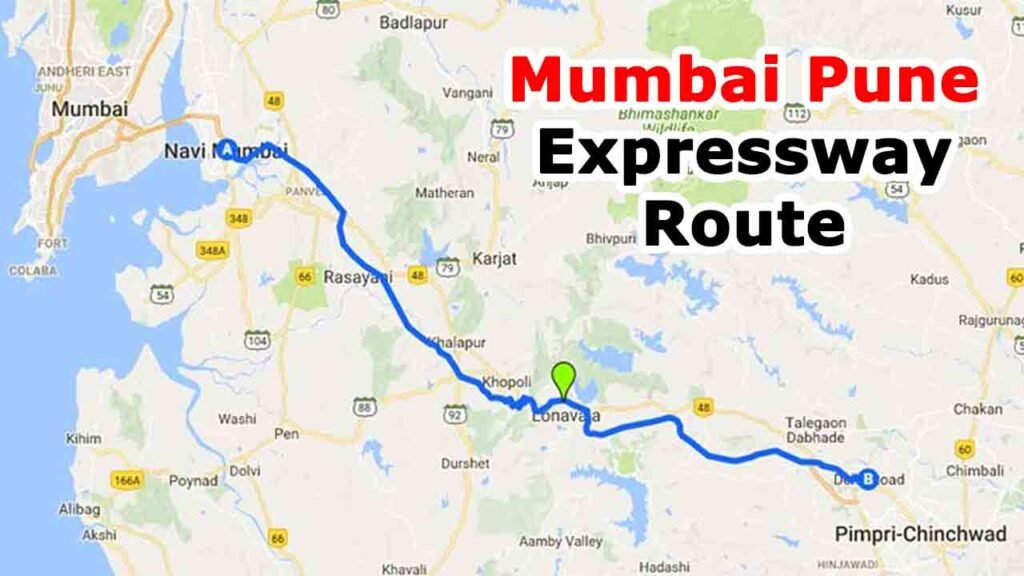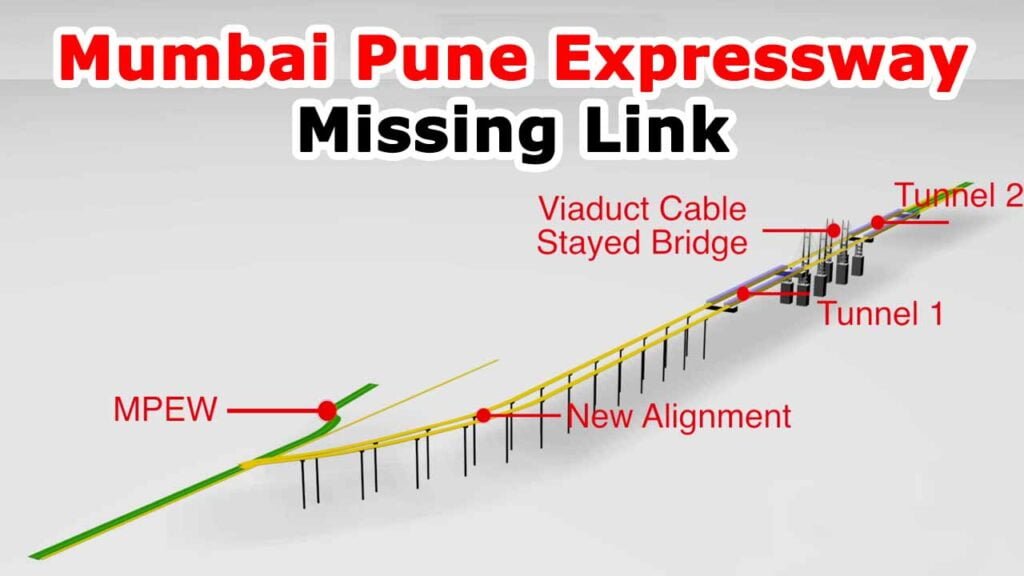The official name of the Expressway is Yashwantrao Chavan Mumbai Pune Expressway. This six-lane expressway replaced National Highway 4 (NH-4), a popular route between Mumbai and Pune. The Mumbai Pune Expressway was launched in 2002, reducing the travel time from Mumbai to Pune by approximately five hours.
The 94-kilometer Mumbai Pune Expressway handles around 60,000 vehicles daily and connects India’s financial capital with Maharashtra’s Pune, an automobile manufacturing and education hub.
Mumbai Pune Expressway Overview
- Length: 94.5 km
- Cost: ₹ 1630 crore
- Lanes: 6 (Expandable to 8)
- Starting Point: Kalamboli, Navi Mumbai, Raigad District
- Ending Point: Ravet, Pune
- Completion Time: April 2002
About the Mumbai Pune Expressway
The Mumbai Pune Expressway is a 6-lane, access-controlled expressway. It is 94.5 km long and connects Raigarh-Navi Mumbai-Mumbai, the capital of Maharashtra state and the financial capital of India, with Pune, the cultural and educational capital of Maharashtra.
The expressway, which was fully operational in 2002, introduced new levels of speed and safety in automobile transportation on roads. It is one of the busiest roads in India. The expressway starts from Kalamboli in Raigad district and ends at Pune Kiwala in Navi Mumbai.
The expressway was inaugurated in April 2002. Initially, the expressway was opened without any specified speed limit. In 2009, however, a speed limit of 80 km/h (50 mi/h) was implemented as private vehicles became more robust and could more easily hold higher speeds. In July 2019, experts reached an agreement on raising the panel speed limit to 120 km/h (75 mi/h). This increase was short-lived; In November 2019, four months later, the Highway Police increased the speed limit for cars to 100 km/h (62 mph) and the speed limit for trucks to 80 km/h (50 mph).
Mumbai Pune Expressway Route

The expressway starts from Navi Mumbai, Raigad district, and ends at Kiwala, Pune. It passes through the beautiful Sahyadri hills through passes and tunnels. It has five accesses: Kon (Shedung), Chowk, Khalapur, Kusgaon, and Talegaon.
The expressway has two carriageways, with three concrete lanes, separated by a central divider and a tarmac or concrete shoulder on either side. Pedestrians, two-wheelers, three-wheelers, bullock carts, and tractors are not allowed; however, semi-trailer rigs and tractor-trailers are permitted. There is also a ban on stopping the vehicle on the expressway.
Mumbai Pune Expressway News and Latest Updates
The expansion of the Mumbai-Pune Expressway has been proposed by the Maharashtra State Road Development Corporation (MSRDC). The authority has proposed to expand the expressway from 6 lanes to 8 lanes to ease the increase in traffic. Apart from this, the authority has also proposed to increase the cost of the project to Rs 280 crore.
The current proposed budget of the Mumbai Pune Expressway is Rs 5800 crore, with the revised estimate being Rs 6080 crore. A significant component of the cost increase in the expansion plan is the construction of additional bridges.
MSRDC has sought funds from the Maharashtra government to expand the highway. If the government does not help, the authorities can take loans and recover the expenses through road tax. The current road tax rate may be increased from 2050 to 2060.
The Mumbai Metropolitan Region Development Authority (MMRDA) proposed that a connector would be built to connect the Mumbai Pune Expressway to the Mumbai Trans Harbor Link (MTHL). The connector is planned to be built in a village called Chirle in Maharashtra. MMRDA has been permitted to build the connector.
Officials said the estimated cost of building this connector between MTHL and the Mumbai Pune Expressway will be around Rs 1,000 crore. The connector will reduce travel time between Pune and Mumbai by about an hour.
Construction of the Chirle connector should begin soon. It will have two separate lanes of road. One road will connect Palaspe to the Mumbai Pune Expressway, while the other road will connect Chirle to Gavhan Phata. The project is expected to be completed in 30 months from commencement.
Mumbai Pune Expressway Missing Link

According to the latest news, Maharashtra State Road Development Corporation (MSRDC) has created a new missing link between Kusgaon and Khopoli. This new extension will reduce the travel time between Pune and Mumbai by 20-25 minutes.
The 13.3-kilometer “Missing Link” project constructed by MSRDC is an 8-lane access-controlled highway being built along the route alignment connecting Khopoli to Kusgaon.
The link aims to overcome the hairpin turns of Khandala Ghat with a series of viaducts, tunnels, and bridges, which are prone to landslides, shorten the distance by 6 km, reduce travel time by 25 minutes, and provide a direct path.
On June 13, 2017, the Cabinet of the Government of Maharashtra approved the project for construction. It is expected to be completed before the current deadline of March 2024 and opened in January 2025.
The project consists of one minor bridge and culverts (11 pipe culverts and two box culverts), two twin tunnels (1.75 km and 8.92 km), and two cable-stayed bridges (770 m and 645 m). The 645-meter-long cable-stayed bridge will have two parallel pillars, which will be about 100 meters above the ground and will be 170 meters high.
Mumbai Pune Expressway Timeline
1990: RITES was entrusted by the Government of Maharashtra in 1990 with the task of studying the feasibility of a new toll-based expressway.
1994: RITES, in its report in 1994, estimated the cost of the project at ₹11.46 billion (US$140 million).
1997: In March 1997, the Government of Maharashtra handed over the construction of the expressway to MSRDC on a build-operate-transfer basis, allowing toll collection for 30 years.
The Ministry of Environment and Forests of the Government of India gave Environment and Forest clearance on 13 October 1997 and Forest clearance on 11 November 1997.
The tender notice was seen in leading newspapers across India and also on the internet. Due to extensive publicity on 18 December 1997, 133 tenders were sold and 55 tenders were received.
1998: After completion of the technical and financial evaluation, work was awarded to four contractors on 1 January 1998. Later tenders were invited to extend the Khandala and Lonavala-Khandala bypass works. Tenders were received on 24 August 1998, and the order was issued on 4 September 1998.
2002: Maharashtra State Road Development Corporation (MSRDC) completed this six-lane project. The expressway was constructed for ₹16.3 billion (US$200 million). The first section opened in 2000, and upon completion, the entire route opened to traffic in April 2002. There is a layer of barbed wire fencing along the entire length of the expressway to keep out stray animals.
Mumbai Pune Expressway Toll Rates
There are a total of five toll plazas on the Mumbai-Pune Expressway to collect toll. Khalapur and Talegaon are two major toll plazas on the expressway. Maharashtra State Road Development Corporation (MSRDC) recently increased toll rates on the Mumbai Pune Expressway by 18 percent from April 1, 2023. Toll charges range from Rs 320 to Rs 2,165 depending on the vehicle. The following are the changed toll rates of the Mumbai Pune Expressway:
| Vehicle type | Toll fee |
| Cars | Rs 320 |
| Mini-buses | Rs 495 |
| Heavy-axle vehicles | Rs 685 |
| Buses | Rs 940 |
| Large trucks | Rs 1,630-2,165 |
Recommended:
Conclusion
The Mumbai-Pune Expressway is not just a road; it is a testament to India’s progress in infrastructure. Its impact has been far-reaching, from reducing travel time to boosting the economy. With the expansion, the expressway will surely become a vital link between Mumbai and Pune. It will further drive the growth of the region and set new benchmarks for road construction in India.
FAQs
1. What is the total length of the Mumbai Pune Expressway?
The Mumbai Pune Expressway spans a total length of 94.5 kilometers.
2. When was the Mumbai Pune Expressway completed?
The expressway was completed and became fully operational in 2002.
4. Are there any safety features on the Mumbai Pune Expressway?
Yes, the expressway is equipped with various safety features, including crash barriers, reflective road markings, and emergency services.
5. What future developments are planned for the Mumbai-Pune Expressway?
Future developments include the expansion of lanes, the introduction of smart road technologies, and the installation of electric vehicle charging stations.

Leave a Reply